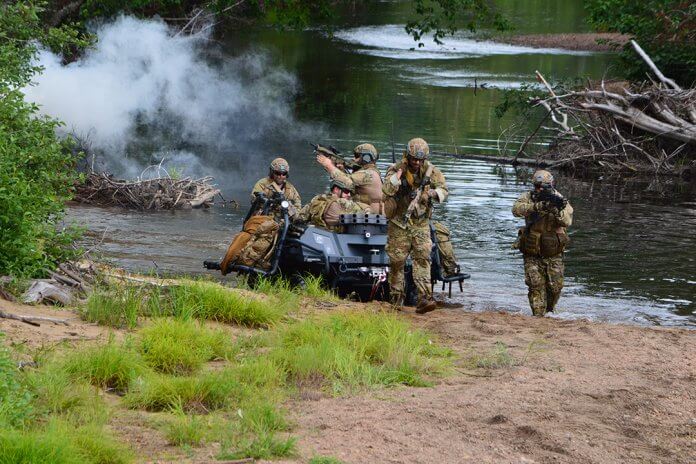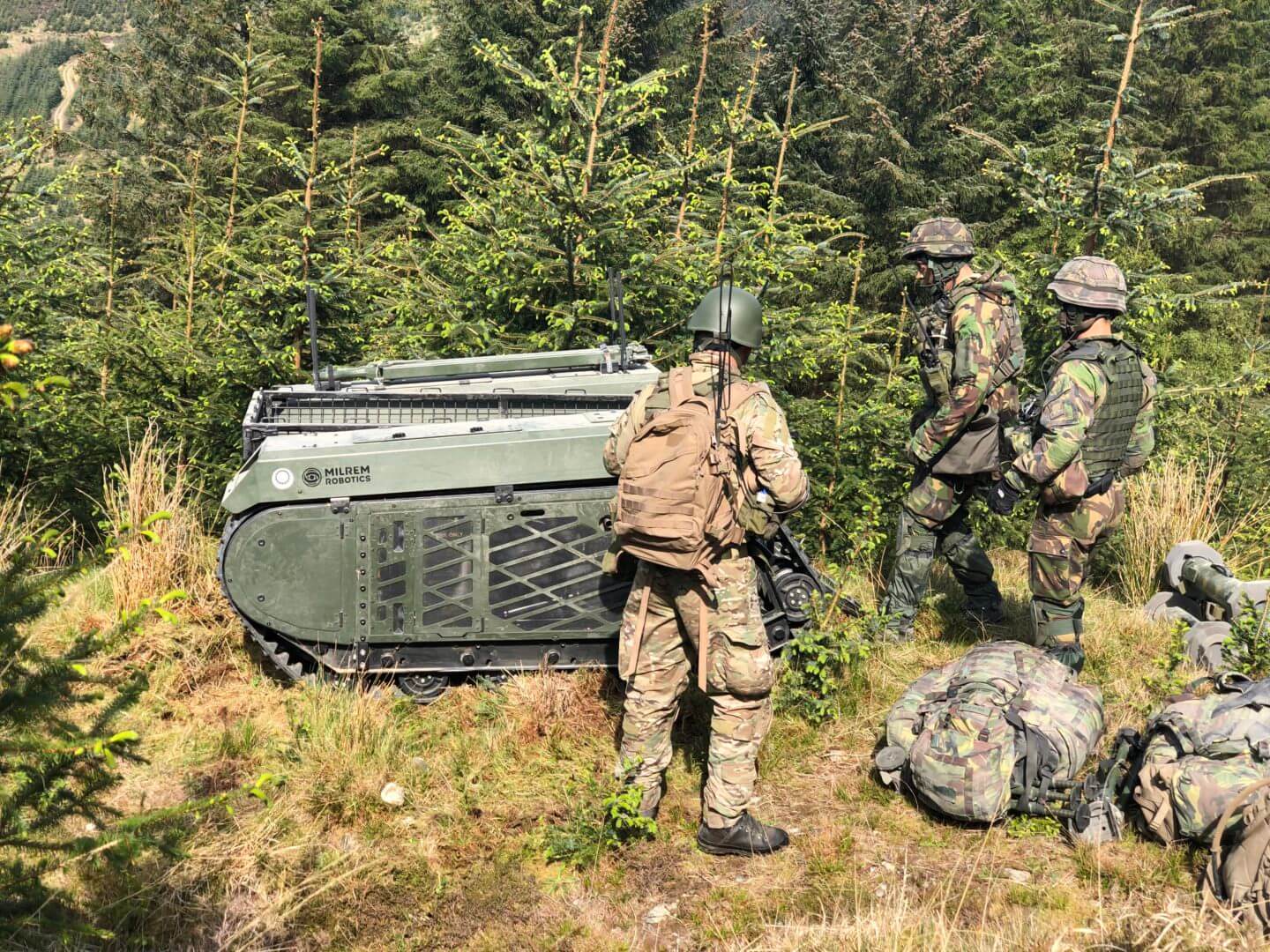
Published in the September 2020 Issue – UGVs will certainly be a welcome addition to supporting soldiers on the battlefield, but the need for complex systems is still being evaluated.
The possibilities for the practical use of Unmanned Ground Vehicles (UGVs) has grown appreciably with the availability of a number of enabling technologies. These include more advanced information processing, digitalisation, compact high resolution video cameras, wireless communication, GPS positioning, hybrid power, and longer life batteries to name just a few. Each provides a critical contribution to building a ground platform that can move under its own power from one point to another with minimal human intervention. This potential capability has been recognised by numerous militaries with an eye to addressing a wide range of tasks both in supporting roles and directly on the battlefield.
Simple ‘robots’ first appeared in the military in the bomb disposal or EOD role to reduce the exposure to danger of the human EOD technician. These were generally used at close ranges with direct control by an operator. Their success brought widespread adoption by military and security forces and encouraged their use in other missions. Currently, UGVs are primarily focused on four applications: logistics carrier/resupply (often referred to as a ‘mule’), reconnaissance, combat, and casualty evacuation/MedEvac. Each task has both common requirements as well as unique challenges.
Pros and Cons
At its current state of development the UGV is primarily a complement to the soldier. They are controlled by, supplement and enhance soldiers capabilities on the battlefield. A logistics ‘mule’ like the General Dynamics wheeled 8×8 Multi-Utility Tactical Transport (MUTT) “can carry 546 kilograms (1,200 pounds) of ammunition, water, extra batteries or support weapons, such as the M4 Carl Gustuav recoilless rifle or Javelin anti-tank missile with spare ammunition” stated a company spokesperson. However the MUTT, which is a contender for the US Army Squad Multipurpose Equipment Transport (S-MET), uses a wireless tethering system that is linked to a soldier within line-of-sight. In April 2020, General Dynamics Land Systems UK delivered two MUTTs to the British Army.

Gert Hankewitz, programme director at Finland’s MILREM developer of the THeMIS UGV points out, ”autonomous travel by a UGV becomes much more difficult when operating off-road and cross-country which is exactly the environment anticipated by the military. The lack of regular and distinct physical markers as found along roadways complicate the independent recognition of obstacles and waypoints. Its ability is further degraded in darkness and limited visibility.”
“Even with an operator in the loop, there are still challenges,” Hankewitz continued. “Operators can experience orientation and perception issues in controlling a UAS. Being separated from the vehicle it is easy to become confused as to its travel in relation to their position and its location on the ground. An overhead view display of these relative positions can reduce this but adds complexity.”
“Another issue is that a remote operator has no sense of the motion and attitude of the vehicle itself,” said Mike Powell of Howe & Howe, designer of the Textron Ripsaw UGV. “The operator has no ‘feel’ for the forces which the vehicle is being subjected to as it responds to commands.” This is further exacerbated by the lack of three-dimensional visual perception inherent in camera video images. As a result, neither on-board driving aids nor the remote operator may recognise a drop-off, such as a ditch or cliff, in front of the vehicle. Powell explained that as a result, “operators will unknowingly push a UGV beyond its limits … and place it in unstable or unsafe situations that can disable it. In field use, roll-overs are the most common accidents that occur.”

Challenges
Brigadier General (ret) Alain Tremblay, vice president, Business Development at Rheinmetall Defence suggested that “building a suitable platform with the mobility and durability needed is well within the capabilities of industry today.” The company’s Mission Master UGV platform is actually derived from the proven ARGOs recreational all-terrain vehicle that is able not only to move with dismounted troops but can even ford water hazards.
“Rheinmetall’s focus is on addressing the software challenges related to providing the UGV with even rudimentary decision making capabilities. The complexity of this grows as the mission tasking of the UGV changes. The cargo UGV may have lower operational expectations than more demanding missions required of a reconnaissance or armed UGV. Tasking a UGV to autonomously evacuate a wounded soldier needs the added assurance that the vehicle will reliably go where it is directed and safety delivery the casualty. The objective is to provide a UGV with a command that it can execute with little or no human intervention”
Affordability
Various nations’ militaries are taking different approaches to the use of UGVs. The United Kingdom would like to employ them on mass almost as a consumable, while the United States and Australia seem to be seeking more sophisticated, and therefore costly, systems. In either case price is a major consideration since a basic rationale of the UGV is that it should be fielded in sufficient numbers so as to supplement and/or replace manned systems in some tasks. However, as Tremblay reflects, “they also need to be sufficiently affordable to allow them to be put at risk without concern over losing a high cost asset.”
One approach toward moderating the price of the UGV is in providing a common package that can be utilised in each of the roles for which it is intended to be configured. The Milrem THeMIS uses a common platform. Hankewitz explained that it is “designed to be reconfigurable for different roles by adding modules. Further, the system is configured so as to be upgradable by accepting new technologies and improved components such as fuel-cell batteries and software.”
Shawn Davy technical director Advanced Programs at Textron Defence, stated that although the company’s Ripsaw UGV “is a fully purpose built system, it uses a modular ‘building block type’ approach that allows the base platform to be reconfigured to various roles. This can often be managed at the forward operating base.
Thremblay adds; “currently sensors are the single greatest expense in a UGV covering three quarters of their cost. This is a major price driver.” In addition, achieving lower production costs could be difficult as the low numbers of systems that are being requested will limit the ability to apply economy of scale savings.
Real Time Control
Probability the greatest challenge to the UGV is achieving a reliable, secure and real-time communication link to and from the UGV. Oleg Martyanov, an ARF manager at Russia’s Advanced Research Foundation, was quoted by Russia’s TASS news agency when he said that his organisation has begun testing the ability of its Marker UGV to respond to the voice commands of its human operator.

However, senior research officer Andrei Anisimov explained at a conference at the Kuznetsov Naval Academy that “modern Russian combat unmanned ground vehicles are not able to perform their assigned tasks in classical types of combat operations.” It has been observed that the effective communication range was often limited to 300-400 metres.
Hankewitz makes the point that “radio frequency control links can be naturally interrupted [by terrain for example], suffer delays in receipt, and are vulnerable to active jamming. Any of these circumstances can result in loss of communications and control.” This possibility is of particular concern with UGVs which require human intervention or decision making. The armed UGV, like the Textron Defence Ripsaw RCV Mark 5, is designed to mount stabilised weapons up to 30mm calibre offering firepower equivalent to an armoured fighting vehicle. But the ability of any armed UGV to employ these weapons remains reliant on positive man-in-the loop control.
Artificial Intelligence
Ted Maciuba, acting director Robotics Requirements at the US Army Manoeuvre Centre of Excellence shared that “advances in artificial intelligence are demonstrating increased situational awareness and the possibility for greater autonomy in executing some tasks, although critical decision making requires human intervention. The challenge here is in perfecting a reliable soldier to system interface that is more intuitive. Achieving better integration within the UGV functions and with the operator are key,” he concluded.
Transformational
“The UGV has the potential to transform warfare,” stated Brigadier General Ross Coffman, director of the US Army Next Generation Combat Vehicle Cross Functional Team. “I am passionate about the potential contributions that they offer. Yet it is relatively new territory, so it is important to determine what works and what doesn’t.” The Army is conducting a series of field experiments that place surrogate UGVs into the hand of soldiers to attempt to determine just this. “We need to define what level of autonomy is not just technically possible but what level we actually want or need in the UGV,” he stated.
Just as the early EOD robots augmented their human technician operators, most concepts for the wider use of UGVs focus on utilising them to undertake tasks that extend current capabilities as an element of a ground operation. The value of the contribution that a UGV would offer in executing the breach of a defended obstacle, providing observation and security in front of friendly units, or conducting forward reconnaissance is unmistakable. The challenge is in how to accomplish this technically but, more importantly, assure its integration and coordination into the broader actions of ground forces. In this sense the UGV may simply be a new element in the tool kit of combined arms.












